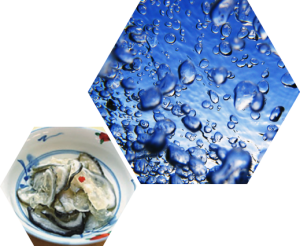
Certified mark for the Aomori PG brand
“A mark gives you peace of mind when selecting proteoglycan products”
About Aomori PG

|
Aomori PG is proteoglycan extracted with technology developed by Hirosaki University, created from the nose cartilage of salmon.
Proteoglycan is the general term for molecules that feature glycan/glycosaminoglycan and core protein modules combined in a fixed manner that resembles stems and branches. It is found in abundance within all animal cartilage and skin, including humans, and works to fill in and solidify the gaps between cells. In other words, it is a key ingredient of the jelly-like extracellular matrix helping to living organisms to maintain their shape. The other major components of this matrix are collagen, hyaluronic acid. |
There’s even more to proteoglycan than its outstanding moisture-retaining powers!
Proteoglycan features a complex branched construction that gives it equal or better moisture-retaining capacity than hyaluronic acid.
For this reason, users taking proteoglycan can anticipate effects such as skin that feels moist and joints smoothly joints.
However, the functions of proteoglycan do not stop at it moisturizing effects. Experiments in which proteoglycan was added to human cells confirmed that proteoglycan increases the amount of collagen and hyaluronic acid in cells. This is a function unique to proteoglycan, and not found with collagen or hyaluronic acid.
|
Up to this point, collagen and hyaluronic acid have commonly been taken as “external supplements” such as beauty serums. However, it may now be possible to take proteoglycan to naturally increase these other components from within the body. Furthermore, we now know that proteoglycan has effects similar to EGF (epidermal growth factor), which is also called the “cell regeneration factor.” It has been proved that proteoglycan solution added to damaged skin cells promotes rebuilding. Additionally, effects such as promoting the metabolism of cells at the outer layer of the skin, reducing joint inflammation, and alleviating colitis symptoms have also been identified. The Hirosaki University has organized proteoglycan effects in chart form. |

|
Proteoglycan is not only an ingredient. It could be the “control tower for regeneration”!
What’s more, it only takes a small amount of proteoglycan to accelerate regeneration of skin and cartilage. It seems to possess a “control tower” effect not found in collagen or hyaluronic acid.
If we compare the composition of our body to a restaurant kitchen, then collagen and hyaluronic acid are only the cooks in the kitchen. Proteoglycan, on the other hand, shows its true value by controlling the entire kitchen in an orderly way, acting as the mighty head chef.
This characteristic means that taking proteoglycan will not only supplement moisturizing existing components, but refresh the skin, joints, and cartilage as well.
However, the structural analysis of proteoglycan has only just begun. What makes it work is still open to speculation. Some clinical trials have shown results that current medical knowledge cannot explain.
This miraculous new component may hold a mystery that current scientific knowledge cannot unravel.
■Go to the “What Makes Proteoglycan So Special?” page
The rather mysterious link between proteoglycan and Aomori
 |
This fixed-structure type glycoprotein was given the name proteoglycan in 1970, and attracted much attention. However, because it is sensitive to heat, and effective ways to extract it had not been developed at that time, a single gram of proteoglycan cost 30 million yen to produce. What’s more, hazardous reagents were necessary for its extraction, making it a “dream ingredient” that was impractical for commercial use. However, a story proving that truth is stranger than fiction unfolded in Aomori, making proteoglycan commercially viable. Research exploring new effective components from agricultural, forestry and fishing resources had been underway in Aomori, Japan, with the Aomori Prefectural Industrial Technology Research Center at its core. In 1990, scientists suspected that they could find proteoglycan at high concentrations in the nose cartilage of salmon. As salmon heads were often unused and discarded, there was anticipation for a sudden burst of new industries that could use salmon heads as a promising resource. It was at this point that Dr. Takagaki entered the picture. He was a researcher at Hirosaki University School of Medicine’s Department of Biochemistry who had a long history of glycan research.
■Go to the “History of Proteoglycan” page
|
What makes it safe?
The Aomori PG Brand Certification System certifies PG products using “Aomori PG” as “safe” and “trustworthy” by the Association for Promotion of Aomori PG.
